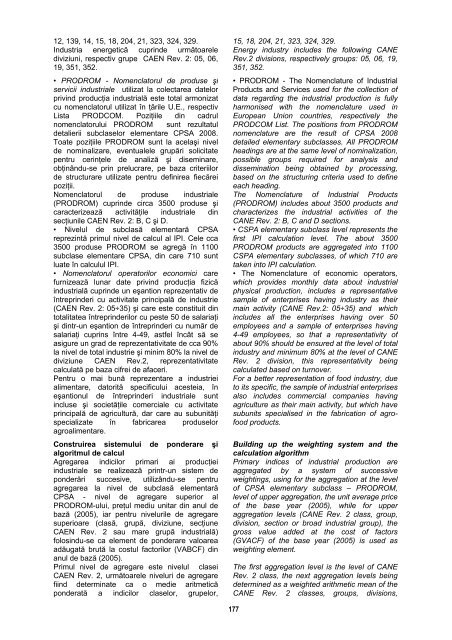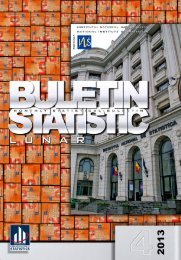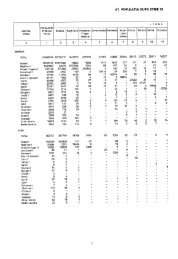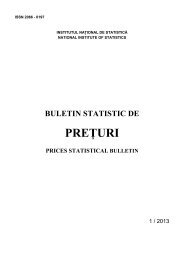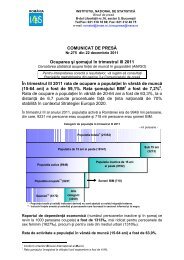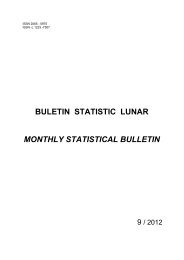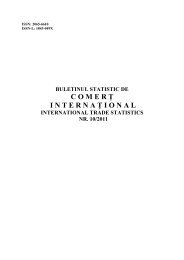BULETIN STATISTIC LUNAR MONTHLY STATISTICAL BULLETIN
BULETIN STATISTIC LUNAR MONTHLY STATISTICAL BULLETIN
BULETIN STATISTIC LUNAR MONTHLY STATISTICAL BULLETIN
You also want an ePaper? Increase the reach of your titles
YUMPU automatically turns print PDFs into web optimized ePapers that Google loves.
12, 139, 14, 15, 18, 204, 21, 323, 324, 329.<br />
Industria energetică cuprinde următoarele<br />
diviziuni, respectiv grupe CAEN Rev. 2: 05, 06,<br />
19, 351, 352.<br />
• PRODROM - Nomenclatorul de produse şi<br />
servicii industriale utilizat la colectarea datelor<br />
privind producţia industrială este total armonizat<br />
cu nomenclatorul utilizat în ţările U.E., respectiv<br />
Lista PRODCOM. Poziţiile din cadrul<br />
nomenclatorului PRODROM sunt rezultatul<br />
detalierii subclaselor elementare CPSA 2008.<br />
Toate poziţiile PRODROM sunt la acelaşi nivel<br />
de nominalizare, eventualele grupări solicitate<br />
pentru cerinţele de analiză şi diseminare,<br />
obţinându-se prin prelucrare, pe baza criteriilor<br />
de structurare utilizate pentru definirea fiecărei<br />
poziţii.<br />
Nomenclatorul de produse industriale<br />
(PRODROM) cuprinde circa 3500 produse şi<br />
caracterizează activităţile industriale din<br />
secţiunile CAEN Rev. 2: B, C şi D.<br />
• Nivelul de subclasă elementară CPSA<br />
reprezintă primul nivel de calcul al IPI. Cele cca<br />
3500 produse PRODROM se agregă în 1100<br />
subclase elementare CPSA, din care 710 sunt<br />
luate în calculul IPI.<br />
• Nomenclatorul operatorilor economici care<br />
furnizează lunar date privind producţia fizică<br />
industrială cuprinde un eşantion reprezentativ de<br />
întreprinderi cu activitate principală de industrie<br />
(CAEN Rev. 2: 05÷35) şi care este constituit din<br />
totalitatea întreprinderilor cu peste 50 de salariaţi<br />
şi dintr-un eşantion de întreprinderi cu număr de<br />
salariaţi cuprins între 4-49, astfel încât să se<br />
asigure un grad de reprezentativitate de cca 90%<br />
la nivel de total industrie şi minim 80% la nivel de<br />
diviziune CAEN Rev.2, reprezentativitate<br />
calculată pe baza cifrei de afaceri.<br />
Pentru o mai bună reprezentare a industriei<br />
alimentare, datorită specificului acesteia, în<br />
eşantionul de întreprinderi industriale sunt<br />
incluse şi societăţile comerciale cu activitate<br />
principală de agricultură, dar care au subunităţi<br />
specializate în fabricarea produselor<br />
agroalimentare.<br />
Construirea sistemului de ponderare şi<br />
algoritmul de calcul<br />
Agregarea indicilor primari ai producţiei<br />
industriale se realizează printr-un sistem de<br />
ponderări succesive, utilizându-se pentru<br />
agregarea la nivel de subclasă elementară<br />
CPSA - nivel de agregare superior al<br />
PRODROM-ului, preţul mediu unitar din anul de<br />
bază (2005), iar pentru nivelurile de agregare<br />
superioare (clasă, grupă, diviziune, secţiune<br />
CAEN Rev. 2 sau mare grupă industrială)<br />
folosindu-se ca element de ponderare valoarea<br />
adăugată brută la costul factorilor (VABCF) din<br />
anul de bază (2005).<br />
Primul nivel de agregare este nivelul clasei<br />
CAEN Rev. 2, următoarele niveluri de agregare<br />
fiind determinate ca o medie aritmetică<br />
ponderată a indicilor claselor, grupelor,<br />
15, 18, 204, 21, 323, 324, 329.<br />
Energy industry includes the following CANE<br />
Rev.2 divisions, respectively groups: 05, 06, 19,<br />
351, 352.<br />
• PRODROM - The Nomenclature of Industrial<br />
Products and Services used for the collection of<br />
data regarding the industrial production is fully<br />
harmonised with the nomenclature used in<br />
European Union countries, respectively the<br />
PRODCOM List. The positions from PRODROM<br />
nomenclature are the result of CPSA 2008<br />
detailed elementary subclasses. All PRODROM<br />
headings are at the same level of nominalization,<br />
possible groups required for analysis and<br />
dissemination being obtained by processing,<br />
based on the structuring criteria used to define<br />
each heading.<br />
The Nomenclature of Industrial Products<br />
(PRODROM) includes about 3500 products and<br />
characterizes the industrial activities of the<br />
CANE Rev. 2: B, C and D sections.<br />
• CSPA elementary subclass level represents the<br />
first IPI calculation level. The about 3500<br />
PRODROM products are aggregated into 1100<br />
CSPA elementary subclasses, of which 710 are<br />
taken into IPI calculation.<br />
• The Nomenclature of economic operators,<br />
which provides monthly data about industrial<br />
physical production, includes a representative<br />
sample of enterprises having industry as their<br />
main activity (CANE Rev.2: 05÷35) and which<br />
includes all the enterprises having over 50<br />
employees and a sample of enterprises having<br />
4-49 employees, so that a representativity of<br />
about 90% should be ensured at the level of total<br />
industry and minimum 80% at the level of CANE<br />
Rev. 2 division, this representativity being<br />
calculated based on turnover.<br />
For a better representation of food industry, due<br />
to its specific, the sample of industrial enterprises<br />
also includes commercial companies having<br />
agriculture as their main activity, but which have<br />
subunits specialised in the fabrication of agrofood<br />
products.<br />
Building up the weighting system and the<br />
calculation algorithm<br />
Primary indices of industrial production are<br />
aggregated by a system of successive<br />
weightings, using for the aggregation at the level<br />
of CPSA elementary subclass – PRODROM,<br />
level of upper aggregation, the unit average price<br />
of the base year (2005), while for upper<br />
aggregation levels (CANE Rev. 2 class, group,<br />
division, section or broad industrial group), the<br />
gross value added at the cost of factors<br />
(GVACF) of the base year (2005) is used as<br />
weighting element.<br />
The first aggregation level is the level of CANE<br />
Rev. 2 class, the next aggregation levels being<br />
determined as a weighted arithmetic mean of the<br />
CANE Rev. 2 classes, groups, divisions,<br />
177


